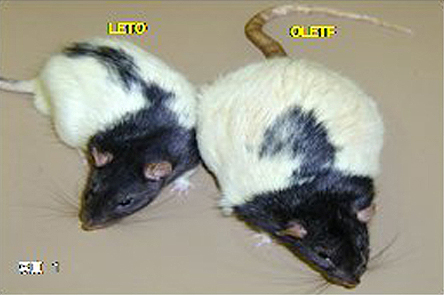| OLETF & LETO (rat model of type 2 diabetes) | |
 |
|||
| Description | The characteristic features of OLETF rats are 1) late onset of hyperglycemia (after 18 wk of age); 2) a chronic course of disease; 3) mild obesity; 4) inheritance by males; 5) hyperplastic foci of pancreatic islets; and 6) renal complication (nodular lesions). [1] Expression of the CCK-A receptor gene in the pancreas and pancreatic exocrine function was examined in diabetic model rats (OLETF). Little or no CCK-A receptor was detected in the pancreas of OLETF rats. Pancreatic exocrine function in response to exogenous CCK and to bile-pancreatic juice diversion (endogenous CCK) was impaired in conscious OLETF rats. [2] We conducted protein loading to examine the progression and pathogenesis of diabetic nephropathy. In OLETF control group, GFR were higher than those in other strains. Glomerular hypertrophy and kidney weights were markedly increased in protein-loaded groups in OLETF rats. Thirty weeks after birth, EM showed that the number of polyethyleneimine (PEI) of the glomerular basement membrane (GBM) in protein-loaded OLETF group was significantly decreased compared to that in control group. These changes in OLETF rats were more marked in the protein-loaded group than those in the control group.Light microscopy showed that the number of exudative lesions with fibrin-cap in the protein-loaded OLETF group was significantly increased than those in control group. In OLETF rats, protein loading caused deterioration of nephropathy at 30 weeks of age. [3] |
||
| Reseach | Human NIDDM Congenital deficiency of CCK-A receptor in the pancreas |
||
| Development | A spontaneously diabetic rat with polyuria, polydipsia, and mild obesity was discovered in 1984 in an outbred colony of Long-Evans rats, which had been purchased from Charles River Canada (St. Constant, Quebec, Canada) in 1982. A strain of rats developed from this rat by selective breeding has since been maintained at the Tokushima Research Institute (Otsuka Pharmaceutical, Tokushima, Japan) and named OLETF. [1] | ||
| Attention | OLETF and LETO (4 weeks of age, male) are available for sale. Breeding is prohibited. |
||
| References | [1] Kawano, K. et al. Spontaneous long-term hyperglycemic rat with diabetic complications. Otsuka Long-Evans Tokushima Fatty (OLETF) strain. Diabetes 41, 1422–8 (1992). [2] Funakoshi, A. et al. Little or no expression of the cholecystokinin-A receptor gene in the pancreas of diabetic rats (Otsuka Long-Evans Tokushima Fatty = OLETF rats). Biochem. Biophys. Res. Commun. 199, 482–8 (1994). [3] Kawano, K., Mori, S., Hirashima, T., Man, Z. W. & Natori, T. Examination of the pathogenesis of diabetic nephropathy in OLETF rats. J. Vet. Med. Sci. 61, 1219–28 (1999). |
